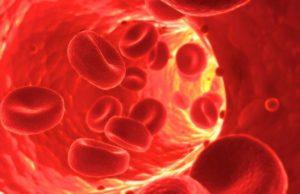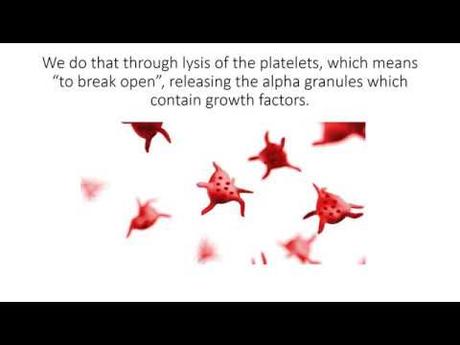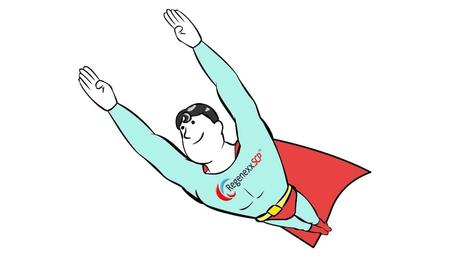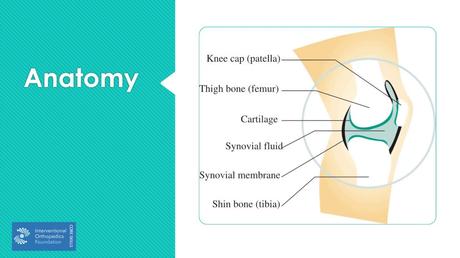Going up and down the stairs is becoming more difficult. Physical therapy and medications have not helped. Your doctor recommends PRP knee injections. What is PRP? How is PRP made? What is involved in the PRP injection process? How do PRP knee injections work? Are PRP knee injections effective for osteoarthritis? How to get the best results from PRP knee injections? Let’s dig in.
What Is PRP?
PRP stands for Platelet-Rich Plasma. Platelets are blood cells that prevent bleeding. They contain important growth factors that aid in healing. Plasma is the light yellow liquid portion of our blood. So PRP is simply a concentration of a patient’s own platelets that are suspended in plasma and are used to accelerate healing. PRP is NOT stem cell therapy. Regrettably, blood contains few circulating stem cells. Rich sources of stem cells are bone marrow and fat.
PRP is rich in growth factors. There are many different types of growth factors with different properties. VEGF is a very important one as it can increase the blood flow to an area. Blood flow brings important nutrients to damaged tissue and can stimulate repair and healing. Regrettably, tendons, ligaments, and most parts of the spine have a poor blood supply (1). This makes injuries difficult to heal. PRP can facilitate repair and healing by increasing the amount of blood flow.
To learn more about PRP please click on the video below.

How Is PRP Made?
The creation of PRP involves several steps which are summarized below.
- Under sterile conditions, your blood is drawn typically from the arm or hand. Volumes drawn vary depending upon the number of areas to be injected and the concentration requested.
- At most clinics, the blood is placed into a centrifuge. This is a machine that spins the blood causing it to separate. Unfortunately, the centrifuge is limited in its ability to customize the PRP. The result is a process where one size fits all. At the Centeno-Schultz Clinic, we utilize a state of the art laboratory with cell biologists on staff that can customize the volume and concentration of the PRP. In this way, you get a very specific and personalized PRP intended for your personal needs. PRP concentration matters. We have published our own research demonstrating that higher concentrations of PRP were more effective in tendon healing in older patients (2).
To learn more about the different types of PRP please click on the video below.

The PRP Injection Process
The use of PRP knee injections is increasingly popular. For the best clinical outcome, the PRP is injected directly into the injured or damaged tissue. For example, in a patient with a patellar tendon tear, it is important that the PRP be injected into the tendon tear. How it is injected is critical. At the Centeno-Schultz Clinic, all injections are performed with either ultrasound or x-ray guidance, or both. Accurate placement of the PRP requires guidance. Blind injections are substandard and should not be tolerated in 2020 as there is no assurance of the PRP getting into the damaged tissue.
Medications to avoid that regrettably are commonly mixed with PRP include:
Toxic local anesthetics: not all anesthetics are the same and some are toxic to cartilage and stem cells (3).
High dose steroids: steroids are toxic to cartilage (4).
How Do PRP Knee Injections Work?
Platelets are rich in growth factors and other important proteins. In PRP the platelets and growth factor and proteins are super-concentrated. Growth factors have critical roles in regulating inflammation and healing of tendons, ligaments, muscles, and bones (5). The major growth factors from PRP that are involved with osteoarthritis treatment include tissue growth factor-B ( TGF-B), insulin growth factor-1, and vascular endothelial growth factor (VEGF) (6). TGG-B promotes growth and differentiation of cartilage-like cells (chondrocytes) whereas VEGF increases blood flow (7).
Are PRP Knee Injections Effective for Osteoarthritis?
To date, there are 27 randomized control studies ( RTC) on PRP knee injections to treat knee arthritis. The studies compared PRP to common treatments such as steroid injections, hyaluronic acid (HA), and physical therapy. PRP knee injections were better than steroids in the treatment of knee osteoarthritis. Cortisone is a powerful anti-inflammatory agent that is commonly used in the treatment of knee osteoarthritis. Recent studies have demonstrated that it is toxic to cartilage and should be avoided (8). Important PRP knee injections studies are summarized below:
2019 study of 120 patients with known early-stage knee osteoarthritis were randomized into three different treatment groups. Group 1 received HA, group 2 steroid, and group three PRP. All participants underwent injections once a week for three weeks. At 6,9 and 12 months, PRP was more effective in reducing pain and increasing function than injected steroids (9)
A 2016 study of 41 patients with knee osteoarthritis compared a single injection of PRP vs corticosteroid. At 6 months PRP was more effective in reducing pain, increasing function, and improving quality of life than corticosteroids (10).
A 2016 critical review of six articles with 739 patients demonstrated that PRP provided a better reduction in pain and increase in function than cortisone ( 11)
Are PRP Knee Injections Better than Excercise Alone in the Treatment of Knee Osteoarthritis?
Physical therapy is often times the first-line treatment option for knee osteoarthritis. The is focused on increasing strength and range of motion. Is PT better than PRP knee injections? Nope. Summarized below are two studies that examined the effectiveness of PRP vs exercises for patients with knee osteoarthritis.
A 2014 study randomized patients with known knee osteoarthritis into two groups: Both groups were prescribed physical therapy. Of the two groups, one received two PRP knee injections. PRP combined with PT was shown to be more effective in reducing pain and increasing function than PT alone (12).
A 2015 study randomized study evaluated the use of transcutaneous electrical nerve stimulation (TENs) vs PRP injections in patients with knee osteoarthritis (13). PRP was more effective in reducing pain and increasing function than TENS unit.
How to Get the Best Results from PRP Knee Injections?
The knee is a complex joint that contains many parts which include cartilage, meniscus, tendons, ligaments, and muscles. All these structures need to be evaluated and treated if appropriate. Regrettably, the majority of all PRP knee injections are simply into the joint which ignores all the other structures. Many of these injections are performed without guidance. Said another way they are blind injections with no assurance that the PRP was injected into the correct structure. This is below the standard of care and should not be tolerated.
At the Centeno-Schultz Clinic, we are experts in the treatment of knee pain. We utilize a comprehensive approach called SANS. It evaluates the stability, Articulation, Neurologic and Symmetry of the Knee Joint. All PRP knee injections are performed with ultrasound and or x-ray guidance. This ensures accurate placement of the PRP. This will allow for the best clinical results. To better understand the importance and skill required for ultrasound-guided injections please click on the video below.

In Conclusion
PRP knee injections are increasingly popular. PRP is platelet-rich plasma which is a concentration of a patient’s own platelets. It is rich in growth factors that can stimulate healing and repair. A patient’s own blood is drawn from the arm or hand and processed removing the red cells and concentrating the platelets. 27 randomized control studies have been completed evaluating the use of PRP in the treatment of knee osteoarthritis. PRP is more effective than steroids and exercise. For the best clinical results, all the different parts of the knee need to evaluated and treated. All PRP knee injections must be performed under guidance to ensure the accurate placement of the concentrated platelets.
If your PCP or orthopedic surgeon discredits or ignores your questions about PRP knee injections remind them there is extensive literature to support its use. If they are not receptive its time to look elsewhere as their biases are preventing them from providing you with the very best care.
Schedule a telemedicine consultation from the comfort of your home. Learn if PRP is right for you. Stop the pain and start living again.
1.Mishra A, et al. Treatment of Tendon and Muscle Using Platelet-Rich Plasma. ClinCports Med 2009; 28:113-125.2. Cook JL, et al. Is Tendon Pathology a
2.Berger DR, Centeno CJ, Steinmetz NJ. Platelet lysates from aged donors promote human tenocyte proliferation and migration in a concentration-dependent manner. Bone Joint Res. 2019;8(1):32–40. Published 2019 Feb 2. doi: 10.1302/2046-3758.81.BJR-2018-0164.R1
3.Dregalla RC, Lyons NF, Reischling PD, Centeno CJ. Amide-type local anesthetics and human mesenchymal stem cells: clinical implications for stem cell therapy. Stem Cells Transl Med. 2014;3(3):365-374. doi:10.5966/sctm.2013-0058.
4.Wernecke C, Braun HJ, Dragoo JL. The Effect of Intra-articular Corticosteroids on Articular Cartilage: A Systematic Review. Orthop J Sports Med. 2015;3(5):2325967115581163. Published 2015 Apr 27. doi:10.1177/2325967115581163
5. Foster TE, Puskas BL, Mandelbaum BR, Gerhardt MB, Rodeo SA. Platelet-rich plasma: from basic science to clinical applications. Am J Sports Med. 2009 Nov;37(11):2259-72. doi: 10.1177/0363546509349921. PMID: 19875361.
6. Cook CS, Smith PA. Clinical Update: Why PRP Should Be Your First Choice for Injection Therapy in Treating Osteoarthritis of the Knee. Curr Rev Musculoskelet Med. 2018;11(4):583-592. doi:10.1007/s12178-018-9524-x.
7.Whitney KE, Liebowitz A, Bolia IK, Chahla J, Ravuri S, Evans TA, Philippon MJ, Huard J. Current perspectives on biological approaches for osteoarthritis. Ann N Y Acad Sci. 2017 Dec;1410(1):26-43. doi: 10.1111/nyas.13554. PMID: 29265418.
8. Kompel AJ, Roemer FW, Murakami AM, Diaz LE, Crema MD, Guermazi A. Intra-articular Corticosteroid Injections in the Hip and Knee: Perhaps Not as Safe as We Thought? Radiology. 2019 Dec;293(3):656-663. doi: 10.1148/radiol.2019190341.
9. Huang, Y., Liu, X., Xu, X. et al. Intra-articular injections of platelet-rich plasma, hyaluronic acid or corticosteroids for knee osteoarthritis. Orthopäde 48, 239–247 (2019). https://doi.org/10.1007/s00132-018-03659-5
10. Forogh B, Mianehsaz E, Shoaee S, Ahadi T, Raissi GR, Sajadi S. Effect of single injection of platelet-rich plasma in comparison with corticosteroid on knee osteoarthritis: a double-blind randomized clinical trial. J Sports Med Phys Fitness. 2016 Jul-Aug;56(7-8):901-8. Epub 2015 Jul 14. PMID: 26173792.
11. Meheux CJ, McCulloch PC, Lintner DM, Varner KE, Harris JD. Efficacy of Intra-articular Platelet-Rich Plasma Injections in Knee Osteoarthritis: A Systematic Review. Arthroscopy. 2016 Mar;32(3):495-505. doi: 10.1016/j.arthro.2015.08.005. Epub 2015 Oct 1. PMID: 26432430.
12. Rayegani SM, Raeissadat SA, Taheri MS, Babaee M, Bahrami MH, Eliaspour D, Ghorbani E. Does intra articular platelet rich plasma injection improve function, pain and quality of life in patients with osteoarthritis of the knee? A randomized clinical trial. Orthop Rev (Pavia). 2014 Sep 18;6(3):5405. doi: 10.4081/or.2014.5405. PMID: 25317308; PMCID: PMC4195987.
13. Angoorani H, Mazaherinezhad A, Marjomaki O, Younespour S. Treatment of knee osteoarthritis with platelet-rich plasma in comparison with transcutaneous electrical nerve stimulation plus exercise: a randomized clinical trial. Med J Islam Repub Iran. 2015 Jun 27;29:223. PMID: 26478881; PMCID: PMC4606945.

